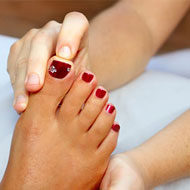- Aromatherapy (36)
- Benefits of Yoga (282)
- Home Remedies (1087)
- massage therapy (9)
- Preventive Therapy (135)
- Running (41)
- Skin Care (15)
- Stress Relief (25)
- Stretching (5)
- walking (33)
- Womens Health (14)
- Yoga Benefits for Pregnant Women (16)
- Yoga Benefits for Students (3)
- Yoga for Children (11)
- Yoga for Holistic Living (37)
- Yoga for Midlife Crisis (3)
- Yoga for Senior Citizens (2)
- Yoga for the Workplace (1)
- Yoga Health Tips (185)
- Yoga Practice during Menstruation (5)
Reflexology Therapy Eases Pain Caused Due To Sciatica

Reflexology For Sciatica
Sciatica is a common form of pain that affects the lower part of your body. It is caused by pressure on the sciatic nerve and results in pain in areas like your lower back and legs. Treatment for sciatica usually involves strong painkillers or anti-inflammatory medication. If conventional medicine has not given you the desired results, or if you would like to increase the range of your treatment, why not try reflexology.
Treatment
A reflexologist usually asks for your health history to completely assess the health of your body and mind before beginning any treatment. This way the treatment most suited to you can be given. The reflexologist then begins to work on the reflex areas to treat sciatica and associated symptoms such as numbness and a tingling sensation. This technique works because when the nerve endings in your hands and feet are stimulated, the corresponding body parts get stimulated too.
According to the reflexologist, the health of the body can be improved by manipulating the energy flow or ‘Qi’ in your body. The human body consists of twelve pathways, or medians, through which the ‘Qi’ flows. In reflexology, pressure points on the hands and feet are can be massaged to stimulate the flow of ‘Qi’ to the associated body parts, thereby correcting imbalances, if any.
The sciatic nerve is the largest nerve in your body and is the main nerve in the leg. It is also the nerve that responsible for transferring back impulses from the sole of the foot to the central nervous system and is therefore important for reflexology.
Reflexology induces the relaxation of muscles and releases any obstructions in the flow of energy. Thus, any tightening of the muscles due to pain or pressure can be eased away by this therapy. Reflexology encourages the release of the body’s natural hormones, such as endorphins, and these can induce an analgesic effect, reducing the pain from sciatica. This therapy also moves the body into a relaxed state where its natural healing abilities can work at optimal levels. Many studies have shown that after a few sessions, the timing and position of the pain and the intensity of the pain have reduced through reflexology.
Reflexology for sciatica should not be used in isolation and is a complementary therapy. Make sure you go to the doctor to check if the sciatic nerve is damaged and get it treated if the pain persists. Regular exercise is also important as the risk of sciatica can be reduced.
- RSS Feeds -
- All posts
- All comments
- Difference between Palm Therapy and Reflexology Palm therapy and reflexology are both forms of alternative medicine. Both pal...
- Back Pain and Massage Therapy Back pain is one of the most common complaints in this day and age. Back pain...
- Massage for Lupus Lupus or Systemic Lupus Erythematosus (SLE) as it is also known as is an auto...
- Deep Tissue Massage Therapy Deep tissue massage therapy is a kind of massage therapy which centers on re...